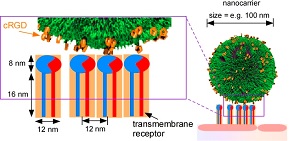 |
| Polymersomes tagged with cRGD allow for better diagnosis and possible drug targeting--Courtesy of the U. of Tokyo |
Researchers in Japan have published a study in the journal Science and Technology of Advanced Materials demonstrating greater potential for nanoparticles that can both carry drugs and act as imaging targets to diagnose malignant tumors in the brain.
The team from the University of Tokyo worked with polymersomes, which are hollow, synthetic capsules that have long been used for drug delivery. To improve them, though, the scientists attached a short chain of amino acids called cyclic RGD to the polymersomes, making the vessels a good tumor tracer, according to Asia Research News. In mice, the nanocapsules accumulated in the blood vessels of glioblastoma tumors and remained in the area for up to 24 hours.
The creation of new blood vessels is highly indicative of malignancy in tumors, and MRIs searching for currently used polymersomes are not as effective when it comes to glioblastomas as they are protected by the blood-brain barrier.
But by loading these polymersomes with superparamagnetic iron oxide, the team could improve the visibility of the vessels in an MRI. All of this can be used for diagnostic purposes, and also for the purpose of drug delivery down the road, the research suggests, by targeting drugs specifically to difficult-to-reach malignant tumors.
- here's the Asia Research News report